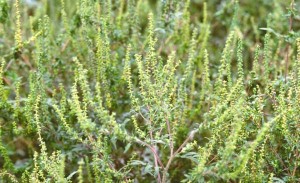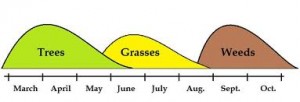Allergies are often associated with watery eyes and sneezing, and in commercials that promote over-the counter anti-allergy pills (antihistamines) the effects are shown as merely bothersome. The commercials are often amusing. The facts for the allergy sufferer are neither amusing nor are allergies a minor bother. They have to be taken serious, as they can affect the quality of life and even be potentially life threatening. A very common plant that can be the culprit for serious allergies is ragweed. Two varieties of the plant are accounting for the worst problems, Ambrosia trifida and Ambrosia artemisiifolia. People who are sensitized to the pollen of ragweed have the most severe symptoms in the months of August to October. Nasal congestion, sneezing, a constantly runny nose and itchiness of eyes, nose and throat are the problems that are encountered by the patient, but asthma can be the more serious consequence. The quality of life in the peak season of ragweed shows significant deterioration for allergy sufferers, as nasal congestion alone is linked to poor sleep quality which in turn leads to decreased productivity at work or in school. A skin rash can be another form of an allergic reaction. It is the less common form of ragweed allergy, but left untreated it becomes chronic and progressively worse. Other herbal products (chamomile and arnica), which may be used as compresses and as an ontment, can cross-react with ragweed exposure and produce a skin rash or dermatitis. Adults are more affected than children, and people with outdoor occupation (farmers, gardeners, harvesters, carpenters) are the group most at risk. Unfortunately, ragweed particles are very small and very light, which makes it very difficult to avoid them in the peak season, but there are measures one can take to avoid exposure.
The peak time of pollen exposure is in the middle of the day, and it is a good idea to keep the windows closed to prevent large amounts of pollen from drifting into your home. The use of an air conditioner in the car or at home can be helpful. After spending time outdoors it can be helpful to change into fresh clothes and perhaps even take a shower. Drying clothes on the laundry line in peak season should be avoided, as they are prone to collect large amounts of pollen.
Timing vacations to leave ragweed-infested areas for other parts of the country can also help. It is also important to take action as soon as symptoms are present. Letting things take their course, will just have a snowball effect. An allergist can do patch tests to determine whether there is a reaction to ragweed. If ragweed dermatitis is present, it has to be treated early on to avoid the difficult to treat chronic state, in which a lower UV threshold is also part of the condition. Decongestants may help with nasal congestion, but unfortunately they tend to cause side effects, such as sleeplessness and a rapid heart beat. The physician can point out the most effective antihistamine to the patient, and intranasal cortico steroids (INCS) may be preferable over oral antihistamines. Newer INCS medications have shown to provide quick control of nasal symptoms, and they can actually minimize the emergence of symptoms, if they are started before the ragweed season begins in mid summer.
More info about asthma: http://nethealthbook.com/lung-disease/asthma-introduction/
Reference: Allergy & Asthma, Summer 2005, page 4-9, page 13-16
Last edited October 29, 2014







